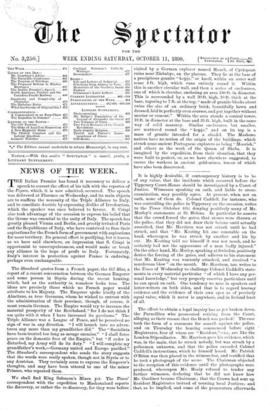We shall find King Solomon's Mines yet. The Times' correspondent
with the expedition to Mashonaland reports the discovery, or rather the re-discovery, for they were before visited by a German explorer named Mauch, of Cyclopean ruins near Zinbabye, on the plateau. They lie at the base of a precipitous granite " kopje," or knoll, within an outer wall some 4 ft. high, which runs entirely round it. Within this is another circular wall, and then a series of enclosures, one of which is circular, enclosing an area 240 ft. in diameter. This is surrounded by a wall 30 ft. high, 10 ft. thick at the base, tapering to 7 ft. at the top, "made of granite blocks about twice the size of an ordinary brick, beautifully hewn and dressed, laid in perfectly even courses, and put together without mortar or cement." Within the area stands a conical tower, 18 ft. in diameter at the base and 35 ft. high, built in the same way of solid masonry. Similar enclosures, but smaller, are scattered round the " kopje," and on its top is a mass of granite intended for a citadel. The Mashona natives have no notion of the origin of the buildings, which struck some ancient Portuguese explorers as being "Moorish," and others as the work of the Queen of Sheba. It is imagined by the expedition, from their situation, that they were built to protect, or, as we have elsewhere suggested, to coerce the workers in ancient gold-mines, traces of which have also been discovered.


















































